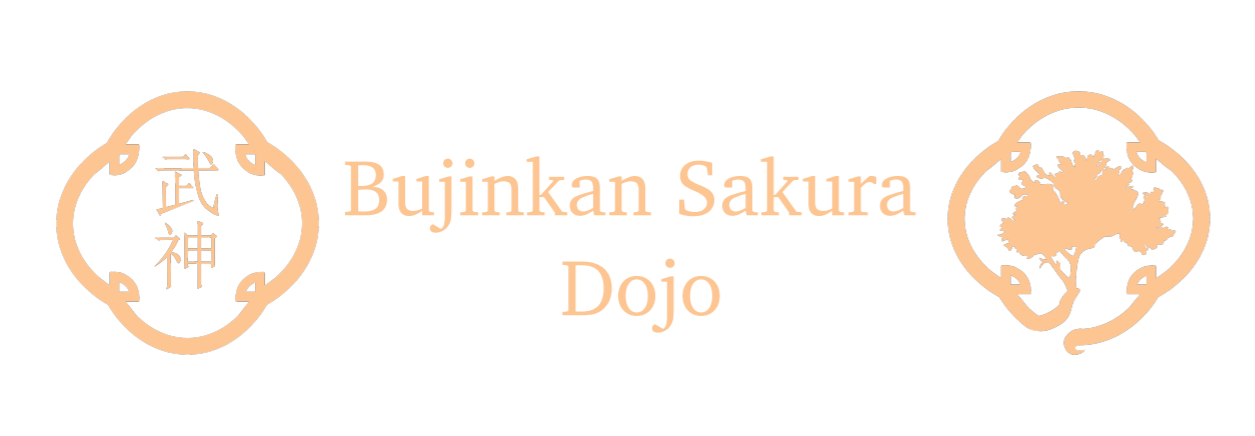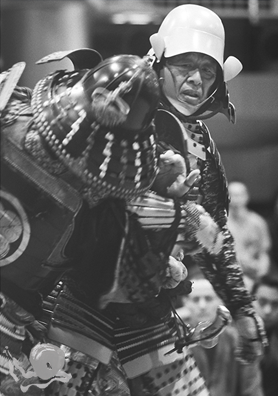Soke Masaaki Hatsumi
Bujinkan Budo Taijutsu was founded by Masaaki Hatsumi (née Yoshiaki
Hatsumi), who was born on 2nd December 1931 and began learning kendo as a 7 year old.
In his youth, Hatsumi was also a skilled and renowned judoka who practiced karate,
aikido, and boxing among others. He instructed American soldiers in judo at the Yokota
army base while studying theatre at Meiji University.
When teaching judo,
Hatsumi noticed that the bigger and stronger soldiers were easily capable of lifting and throwing seasoned black belts
after only a short period of training
. Because of this, he began searching ways of beating physically larger opponents more effectively.
Following his graduation from university, Hatsumi trained in several different koryu, or old martial styles
under different master’s until he met Toshitsugu Takamatsu (1889-1972) who became his teacher.
Hatsumi also studied to become a Japanese
Seikotsu physical therapist at Takamatsu’s suggestion. His treatment clinic served a double purpose, functioning as his budo practice hall in the evenings
Later on, the Hombu-dojo was build in Noda, Tokyo as the head Bujinkan training hall.
During fifteen years of training, Takamatsu bestowed the title of Grand Master upon Hatsumi in nine different martial arts in Nara, Japan.
These are listed as follows:
Togakure-ryū Ninpō Taijutsu (戸隠流忍法体術)
Gyokushin-ryū Ryū Ninpō (玉心流忍法)
Kumogakure Ryū Ninpō (雲隠流忍法)
Koto Ryū Koppō jutsu (虎倒流骨法術)
Gyokko-ryū Kosshi jutsu (玉虎流骨指術)
Kuki Shinden Happō Bikenjutsu (九鬼神伝流八法秘剣術)
Shinden Fudo Ryū Dakentai jutsu (神伝不動流打拳体術)
Takagi Yoshin Ryū Jūtai jutsu (高木揚心流柔体術)
Gikan Ryū Koppō jutsu (義鑑流骨法術)
When international interest in Bujinkan grew, Hatsumi started teaching
it with various yearly themes beginning in 1988. At the annual Daikomiosai camp in December,
he always announced the coming year’s theme and brought the current year’s theme to its conclusion,
thus shifting the focal point of Bujinkan training according to the new theme
.
Bujinkan yearly themes:
2017-2019 – Muto Dori
2015 – Nagamaki
2014 – 神韻武導 Shin In Bu Dou / 神 SHIN, JIN god, divinity; mind, soul / 韻 IN rhythm; elegance; melody / 武 BU, MU war, martial skills, chivalry. Bu tai Mu refers to a soldier, Bushi or Musha / 導 DŌ to lead, to guide.
2013 – Ken Engetsu no Kagami (‛Mirror of the Full Moon Sword’)/ Tachi Hôken (‛Sword of Holy Treasure’)— Ken, Tachi, and Katana/ Naginata and Yari
2012 – Jin Ryo Yo Go – Kaname, sword and Rokushakubo, separately and dual-wielding
2011 – Kihon Happo
2010 – Rokkon Shoujou
2009 – 才能 魂 器 ”saino konki”/ Talent, heart, capacity / Talent, soul, capacity
2008 – Togakure-ryū Ninpō Taijutsu
2007 – Kukishin Ryu
2006 – Shinden Fudo Ryu
2005 – Gyokko-ryū Kosshi jutsu (Bo and Tachi)
2004 – Daishou Juutai jutsu (Roppo-Kuji-no Biken)
2003 – Juppo Sessho
2002 – Jutai jutsu (Takagi Yoshin Ryu)
2001 – Kosshi jutsu (Gyokko Ryu)
2000 – Koppo jutsu (Koto Ryu)
1999 – Kukishinden Ryu
1998 – Shinden Fudo Ryu
1997 – Jojutsu
1996 – Bokken
1995 – Naginata
1994 – Yari
1993 – Rokushakubojutsu
1992 – Taijutsu voima
1991 – Sword and Jutte
1990 – Hanbo
1989 – Taijutsu and weapons
1988 – Taijutsu
Upon reaching 88 years of age on 2nd December 2019, Hatsumi passed on his title of Grand Master
to his students as follows:
Togakure-ryū – Tsutsui Takumi
Gyokushin-ryū – Kan Jun’ichi
Kumogakure-ryū – Furuta Kōji
Kotō-ryū – Noguchi Yukio
Gyokko-ryū – Ishizuka Tetsuji
Kukishin-ryū – Iwata Yoshio
Shinden Fudō-ryū – Nagato Toshirō
Takagi Yōshin-ryū – Sakasai Norio
Gikan-ryū – Sakasai Norio


